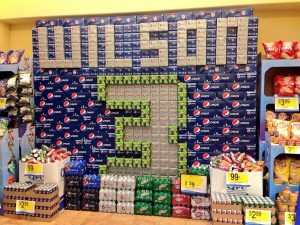The industrialization of food has brought along with it billions of dollars of food marketing to get the shopper to spend that extra few dollar on the newest product. Pollan mentions that the food marketing industry has an annual budget of about thirty-two billion dollars (4). Along with the marketing being shown on television commercials, on billboards, there are more subtle strategies to get you to buy more and more, usually processed, food. One of those places is the grocery store. From the displays on the aisle caps to the giant soft drink monuments when you walk through the door, the grocery store is no innocent arena. It is no wonder that Pollan suggests we keep to the out of the middle of grocery stores and to shop the peripheries (157).
From the first, has anyone noticed the increase in the sizes of carts over the years? They have increased dramatically, giving the shopper the impression that they don’t have enough. The fresh flowers at the front of the store bring the ideas of freshness and good times as a first impression. They are often placed on the right-hand side of the entrance, as people have been found to prefer walking around stores in a counter-clockwise direction (Real Simple).

The staples, meat, dairy and fresh produce are all usually as far from one another as can be, compelling the shopper to cross the entirety of the store even if they have a few things on their list. Oh, the list… you promise yourself to stick to it fully, only for that free sample and new flavor of chips to sneak its way into your cart.
When you do get into the aisles, let’s say the cereal aisle, you find more strategies to fill the cart. The children’s cereals are placed at their eye level, while the “adult” cereals are higher up. The generic store brands are typically in the most inconvenient places, although they are usually the cheapest (Real Simple). And these examples are only touching the surface of the plethora of often unconscious influences on our buying choices.
So how can we avoid these psychologic tricks? One easy way is to apply the rules and recommendations that Pollan makes. Suggestions like sticking to foods with less than 5 ingredients, shopping the peripheries of the store, and making an effort to buy food rather than those oh-so-intriguing food-like substances. Have you ever fallen for these tricks? Now that you know more about them, will you make an effort to outsmart the grocery store?
References:
Pollan, Michael. In Defense of Food: An Eater’s Manifesto. New York: The Penguin Press. 2008.
The Secret Behind Your Grocery Store’s Layout. Real Simple. https://www.realsimple.com/food-recipes/shopping-storing/more-shopping-storing/grocery-store-layout#supermarket-layout .
Shopping Cart: https://www.georgeinstitute.org.au/sites/default/files/main-images/supermarket.jpg
Soda Can Display: http://profootballzone.com/nfl/grocery-store-impressive-russell-wilson-soda-display-photo/
